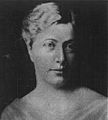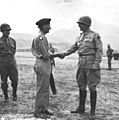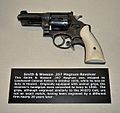Patton facts for kids
Patton is a name that can mean a few different things, but it is most famously known for George S. Patton, a very important U.S. Army general during World War II. He was a strong and sometimes controversial leader who played a big part in many key battles.
Contents
Who Was George S. Patton?
George S. Patton Jr. (1885–1945) was an American general who served in the U.S. Army for many years. He was known for his leadership of armored forces and his quick, aggressive tactics. Patton was a key figure in the Allied victory during World War II.
Early Life and Education
Patton was born in California into a family with a long history of military service. He went to the Virginia Military Institute for one year before transferring to the U.S. Military Academy at West Point. He graduated in 1909.
Early Military Career
After graduating, Patton became a cavalry officer. He was very skilled in sports and even competed in the first-ever modern pentathlon at the 1912 Summer Olympics in Stockholm, Sweden.
Patton also served in the Pancho Villa Expedition in Mexico in 1916. This was one of the first times the U.S. Army used motorized vehicles in combat.
World War I Service
During World War I, Patton went to France. He was one of the first officers assigned to the new U.S. Tank Corps. He helped set up the first American tank school and led tank brigades in battle. This experience showed his early interest in armored warfare.
Between the World Wars
After World War I, Patton continued to develop his ideas about tank warfare. He believed that tanks would be very important in future wars. He wrote articles and gave speeches about how to use tanks effectively. He also attended various military schools to improve his skills.
World War II Leadership
When World War II began, Patton quickly rose through the ranks. He led American forces in the invasion of North Africa in 1942. His troops then fought in the invasion of Sicily in 1943. He was known for pushing his soldiers hard and moving very quickly.
The Battle of the Bulge
One of Patton's most famous moments was during the Battle of the Bulge in late 1944. German forces launched a surprise attack, creating a large "bulge" in the Allied lines. Patton quickly moved his Third Army hundreds of miles to relieve American troops trapped in Bastogne, Belgium. This quick action helped turn the tide of the battle.
Advance into Germany
After the Battle of the Bulge, Patton's Third Army continued to advance into Germany. They played a crucial role in defeating Nazi Germany. Patton's leadership and aggressive tactics were key to the Allied victory in Europe.
After the War and Legacy
After Germany surrendered, Patton was involved in the occupation of Germany. He died in December 1945 from injuries sustained in a car accident.
Patton is remembered as one of the most effective and daring generals in American history. His focus on speed and surprise in armored warfare changed how battles were fought.
Other Uses of the Name Patton
The name Patton is also used for other things:
- Patton is a famous 1970 movie about General George S. Patton. It won several awards.
- The Patton tank is a series of American tanks named after General Patton. These tanks were used by the U.S. Army for many years after World War II.
- Charley Patton was an important American blues musician who lived from 1887 to 1934. He is considered one of the earliest and most influential blues guitarists.
- Mike Patton is an American musician known for his work in various bands, including Faith No More.
Images for kids
-
Anne Wilson "Nita" Patton, Patton's sister. She was engaged to John J. Pershing in 1917–18.
-
Patton at the Virginia Military Institute
-
Patton (right) fencing in the modern pentathlon of the 1912 Summer Olympics
-
The durability of the 1915 Dodge Brothers Model 30-35 touring car won renown for the new automaker following its use in the 1916 Pancho Villa Expedition
-
Patton as a temporary colonel at Camp Meade, Maryland, 1919
-
Writer Hal Block (far left), comedian Bob Hope (second from left), writer/actor Barney Dean, singer Frances Langford and musician Tony Romano meet George Patton in Sicily during World War II
-
Patton (left) with Rear Admiral Henry Kent Hewitt aboard USS Augusta, off the coast of North Africa, November 1942
-
From left to right, Brigadier General Theodore Roosevelt Jr., Major General Terry Allen and Lieutenant General George S. Patton, March 1943.
-
Lieutenant Colonel Lyle W. Bernard, commanding the 2nd Battalion, 30th Infantry Regiment, in conversation with Lieutenant General George S. Patton, commanding the U.S. Seventh Army, near Brolo, Sicily, July 1943.
-
General Sir Bernard Montgomery shakes hands with Lieutenant General George S. Patton at an airport at Palermo, Sicily, July 28, 1943. Major General Geoffrey Keyes, deputy commander of Patton's Seventh Army, is stood to the far left of the picture.
-
Patton pins a Silver Star Medal on Private Ernest A. Jenkins, a soldier under his command, October 1944
-
From left to right: Major General Leven C. Allen, Lieutenant General Omar Bradley, Major General John S. Wood, Lieutenant General George S. Patton and Major General Manton S. Eddy being shown a map by one of Patton’s armored battalion commanders during a tour near Metz, France, November 1944.
-
From left to right, Bradley, Eisenhower and Patton in Bastogne, Belgium, 1945
-
Patton's grave in Luxembourg City
-
A replica of Patton's World War II command vehicle on display at the Lone Star Flight Museum in Houston, Texas
-
A statue of Patton at the US Military Academy at West Point
-
Patton's boots at a museum in Malmedy
See also
 In Spanish: George Patton para niños
In Spanish: George Patton para niños

























